Table of contents

Cook
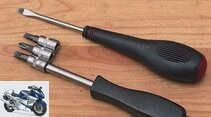
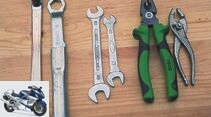

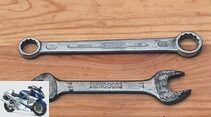
8th pictures
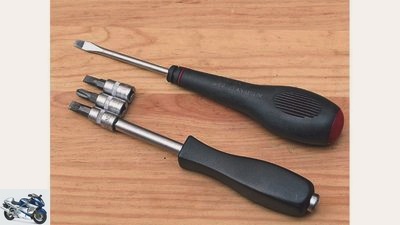
Cook
1/8
Solid screwdrivers with a handy shaft are preferable to tools with bits.
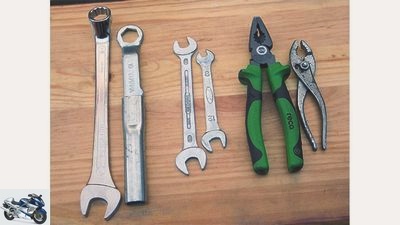
Cook
2/8
The standard on-board tools are replaced by good quality retrofit tools.
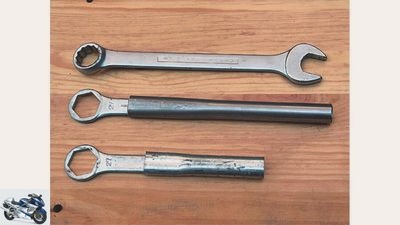
Cook
3/8
Combination wrench, center tool kit with extension, below with sheet metal lever.
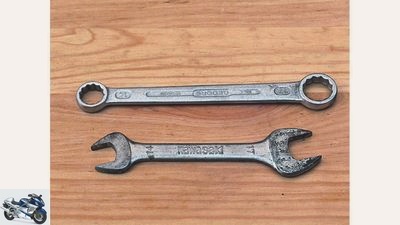
Cook
4/8
In the tool trade, wrench sizes can be combined, here 12 and 14 mm.
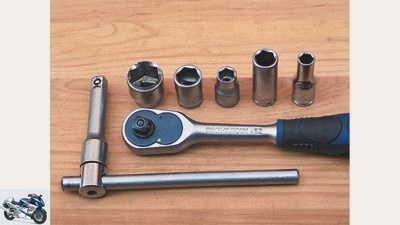
Cook
5/8
Practical and easy to hold: 3/8 inch ratchet with sockets and toggle for the hobby workshop.

Cook
6/8
The tool kit provides information on which wrench sizes and screw heads are used on the motorcycle. In the event of a breakdown, cheap keys and pliers are better than nothing. For the enthusiastic hobby mechanic, however, they are taboo, especially since there is a risk of injury and breakage when handling.
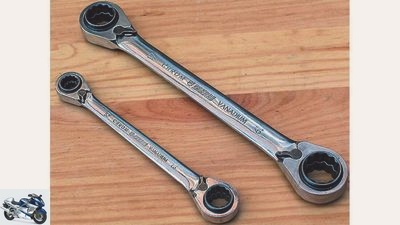
Cook
7/8
Practical “ring spanners” with adjustable ratchet mechanism in tight spaces.

Cook
8/8
When driving out wheel axles or engine bolts, only an aluminum mandrel is used.
counselor
workshop
Advice: Buy the right tool
Advice: Buy the right tool
Purchase advice tool
If you not only enjoy driving, but also screwing, you need the right tool. And that doesn’t necessarily have to be the 250-piece tool set from the hardware store.
Werner Koch
04/15/2010
Everything is there. Tying wire for the flowers, stone drills to peg the garden swing in place, lots of wax screws, dried paint brushes – only the right tool for removing the wheel has crumbled out of the huge universal tool box. No, it won’t work that way. If you want to screw down your beloved motorcycle, MOTORRAD recommends storing a compact but cleverly selected assortment of tools in the specially purchased suitcase.
In this way you can limit the loss (or have you never rediscovered your expensive combination pliers years later in the sandpit?), And the eternal search for the right nut is also an end. So, leave the toolbox for household and car in the basement and get on your way. There where even men go shopping willfully and without excuses: to the tool dealer. So that your credit card is not blocked afterwards, make a shopping plan beforehand. And think about what quality you stock up on. Tips and tricks on how to recognize good tools and sort out botches were already revealed in MOTORRAD issue 4/2010.
- Level one, for those who rarely use tools, is based on the content of the on-board tool kit. As a rule, and especially with Japanese machines, this is a real breakdown set in a double sense. It doesn’t matter, the key widths of the punched parts tell the hobby hobbyist which shelf to reach.
In the well-stocked tool trade there are open-end and ring spanners that do not have the standardized combination of 10/11, 12/13 or 14/15, but a selectable combination, as is usually included in on-board tools (see photo show Fig. 2 ). The following combinations are recommended as open-end and ring spanners for common Japanese machines: 7/8, 10/12, 12/13, 14/17, 17/19.
All wrench sizes above are usually only intended for the axle nuts and should be used as socket wrenches, colloquially “nut”, can be purchased with the appropriate ratchet.
The wrench sizes 8, 10 and 12 should be used as open-end wrenches in duplicate in order to loosen locked screw connections (throttle cable length adjuster, chain tensioner).
- The bigger the tools are, the stricter the prices. Combined combination wrenches and open-end wrenches that are purchased in the sizes actually required have therefore proven their worth in practice. With the following standard wrench sizes you can make good progress with motorcycles: 22, 24, 27, 30 and 32 millimeters.
Even larger hex nuts with 36 or 41 millimeters are installed on some rear axles. However, nuts in these sizes have a ¾-inch drive that can only be adapted to the ½-inch ratchet with a reducing insert.
At this stage, hobby handicrafts slowly move into stage three and cost a fair amount of money. Money that can be saved for the one-time removal of the rear wheel. All you need to do is put your hand in the tool kit to pry open the axle nut with the appropriate ring spanner. Since this is no fun with the sheet metal extensions that are too short, a steel tube about 250 millimeters in length can be cut to size at a metalworking shop, which is slipped over the shaft of the on-board tools (see photo show Fig. 3).
- If you intend to do more than just remove the wheel every year, you should use the caliper gauge to measure the width across flats of the wheel axles and steering head nut in the second stage before shopping.
Anything over 22 millimeters across is combined with the stable ½ inch ratchet. The handy, but sufficiently stable 3/8 inch socket wrench sets are recommended for all wrench sizes below this (see photo show image 4).
- The ¼-inch ratchets included in the socket wrench sets are too delicate for working on the motorcycle and the levers for most M8 or M10 screws are too short to apply the correct tightening torque to the ratchet.
- When buying 3/8-inch tools, we also use the motorcycle as a guide and put an 8, 10, 12, 14, 17 and 19 socket each into the shopping basket. For European bikes, a 13 mm nut is added – that’s enough. As you can see, the “intermediate sizes” 9, 11, 15, 16 or 18 are not used on current motorcycles and only fill the tool box unnecessarily. Which means that our new “on-board tool kit” has barely improved in terms of quantity, but has significantly improved in quality and application (see photo show image 5).
- In order to avoid surprises, you can find out from your authorized dealer which tools are necessary when it comes to the nitty-gritty. Especially with Torx screw heads, the insert must be absolutely precise so as not to over-tighten the fine toothing.
- Better than a complete set with a small ratchet, twist grip and countless plug-on bits are handy T-keys for Allen or Torx heads. They lie comfortably in the hand and convey a better feeling for the torque and possible defects in the thread or toothing. Sizes 3, 4, 5 and 6 millimeters are recommended as standard sets for Allen keys. T-keys are not very useful for screws with M10 threads or more, as the required tightening torque can only be achieved with enormous manual force. This is why the ½ inch ratchet with the corresponding Allen nuts is also used here.
- With slotted or Phillips screwdrivers you can make do with the slip-on bits from the range, but you only have a chance against stuck slotted screws with an ergonomically well-shaped handle of a high-quality screwdriver with a suitable blade (see photo show Fig. 6).
The ratchet wrenches with adjustable tightening directions prove their worth with hidden screws (e.g. fork bridge clamps on motorcycles with fairings) (see photo show Fig. 7). These tools work excellently where a ratchet is too bulky and an open-ended wrench is impractical to move. Versions that have four different wrench sizes on one tool are very universal.
- Universal and therefore indispensable are also combination pliers, but they can only fulfill their versatile function if they are of good quality. When buying, make sure that the cutting edges do not have an air gap in the backlight and that the corrugated front part of the pliers does not rest on it. This is the only way to guarantee a perfect cutting function even with thin wire and fine cables.
- An important part of the motorcycle tool: an aluminum mandrel that can be used to drive out wheel axles without screwing up the thread. Simple and inexpensive: have an approx. 300 millimeter long aluminum round material of medium hardness with a diameter around two millimeters smaller than the wheel axle cut to size in the hardware store. Anyone who can fall back on the beneficial equipment of a lathe turns the tips with three different diameters (see photo show Fig. 8). This means, for example, that firmly corroded screws can be loosened with a short blow on the head without destroying it.
- In MOTORRAD 13/2010 we reveal which tricks can help with messed up, stuck screws and nuts.
<!– ESI FOR ads.BannerGallery / irelements / esielement / eyJwYWdlIjoiL3N0YXJ0c2VpdGUvIiwibGF5b3V0IjoiYXJ0aWNsZSIsImVsZW1lbnQiOiJhZHMuQmFubmVyR2FsbGVyeSIsImlyQ29uZmlnIjoiMTQ3MDY0NDAiLCJwYXJhbXMiOnt9LCJpc01vYmlsZSI6ZmFsc2V9 –> <!– CACHEABLE –>&# 34;,&# 34; rectangle&# 34 ;: “<!–# include virtual = \&# 34 / irelements / esielement / eyJwYWdlIjoiL3N0YXJ0c2VpdGUvIiwibGF5b3V0IjoiYXJ0aWNsZSIsImVsZW1lbnQiOiJhZHMuUmVjdGFuZ2xlR2FsbGVyeSIsImlyQ29uZmlnIjoiMTQ3MDY0NDAiLCJwYXJhbXMiOnt9LCJpc01vYmlsZSI6ZmFsc2V9 \&# 34; –> <!– ESI FOR ads.RectangleGallery / irelements / esielement / eyJwYWdlIjoiL3N0YXJ0c2VpdGUvIiwibGF5b3V0IjoiYXJ0aWNsZSIsImVsZW1lbnQiOiJhZHMuUmVjdGFuZ2xlR2FsbGVyeSIsImlyQ29uZmlnIjoiMTQ3MDY0NDAiLCJwYXJhbXMiOnt9LCJpc01vYmlsZSI6ZmFsc2V9 –> <!– CACHEABLE –>&# 34;,&# 34; sky&# 34 ;: “<!–# include virtual = \&# 34 / irelements / esielement / eyJwYWdlIjoiL3N0YXJ0c2VpdGUvIiwibGF5b3V0IjoiYXJ0aWNsZSIsImVsZW1lbnQiOiJhZHMuU2t5R2FsbGVyeSIsImlyQ29uZmlnIjoiMTQ3MDY0NDAiLCJwYXJhbXMiOnt9LCJpc01vYmlsZSI6ZmFsc2V9 \&# 34; –> <!– ESI FOR ads.SkyGallery / irelements / esielement / eyJwYWdlIjoiL3N0YXJ0c2VpdGUvIiwibGF5b3V0IjoiYXJ0aWNsZSIsImVsZW1lbnQiOiJhZHMuU2t5R2FsbGVyeSIsImlyQ29uZmlnIjoiMTQ3MDY0NDAiLCJwYXJhbXMiOnt9LCJpc01vYmlsZSI6ZmFsc2V9 –> <!– CACHEABLE –>&# 34;}}” ga-track-vis =”article.gallery.inline.vis” class =”v-A_-article__inline-container”>
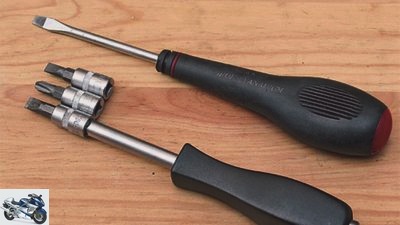
Cook




8th pictures
Pictures: Guide: Buy the right tool
go to Article
To home page
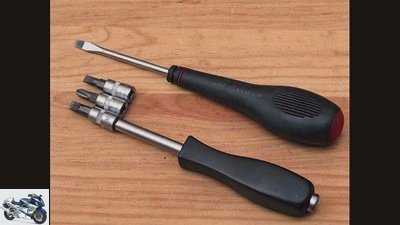
Cook
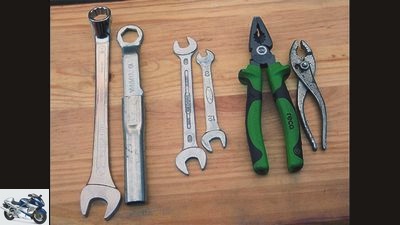
Cook
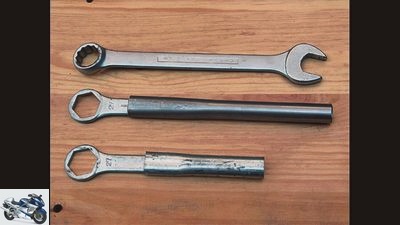
Cook
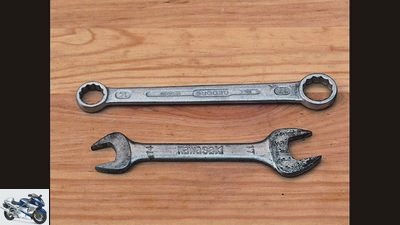
Cook
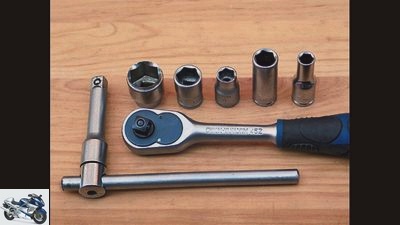
Cook
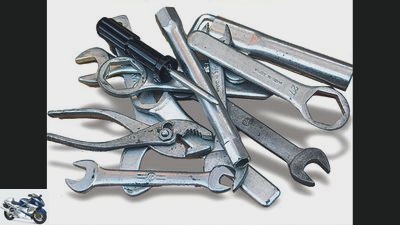
Cook

Cook
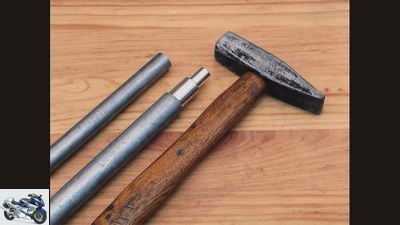
Cook
1/8
More about technology
PS knowledge: technology
- Motorcycle technology clearly explained on 97 pages (PDF)
- From starter to spark plug
- Simple teaching of physical principles
- Tips and tricks for practitioners
To the PDF for € 9.99
#image.jpg
Related articles
-
Buy the right way: basic tools
Rutz counselor workshop Buy the right way: basic tools Buy right Basic tools Great offer: 100 pieces for 29.95 euros. You can’t go wrong with that, can…
-
Advice: Find the right air pressure
Schermer counselor workshop Advice: Find the right air pressure Advice: Find the right air pressure The right air pressure on a motorcycle The topic of…
-
Product test inexpensive tool case
mps photo studio counselor workshop Product test inexpensive tool case Product test: tool case How good are cheap tool cases really 100 parts for 100…
-
Basic screwdriver tip for the 1st tool collection
Ralf Petersen 13th pictures Ralf Petersen 1/13 This screwdriver tip is about the most elementary basics. Everyone started out very small and simple. For…
-
Second-hand advice: ABS bikes up to 4000 euros
Jahn counselor Used purchase Second-hand advice: ABS bikes up to 4000 euros Second-hand advice: ABS bikes up to 4000 euros Cheap ABS bikes Most want it,…
-
Used advice Honda CB 750 Seven Fifty
counselor Used purchase Used advice Honda CB 750 Seven Fifty Used advice Honda CB 750 Seven Fifty Hydro culture What do the CB 750 and these plants have…
-
Advice: check and adjust steering head bearings
Cook 9 pictures Cook 1/9 Checking and adjusting the steering head bearing – Step 2: Loosen the central nut on the steering shaft. Only use a nut and a…
-
counselor Used purchase Used advice Honda CB 500 Used advice Honda CB 500 From the same mould Honda’s new model in the inexpensive entry-level class had…
-
Yamaha counselor Used purchase Yamaha Vmax used advice Second hand advice Yamaha Vmax (1985 – 2010) The Yamaha muscle bike as a used one The rare cross…
-
Second-hand advice on Honda CX models
MOTORCYCLE archive counselor Used purchase Second-hand advice on Honda CX models Second-hand advice on Honda CX models Rarity value The Honda CX models…